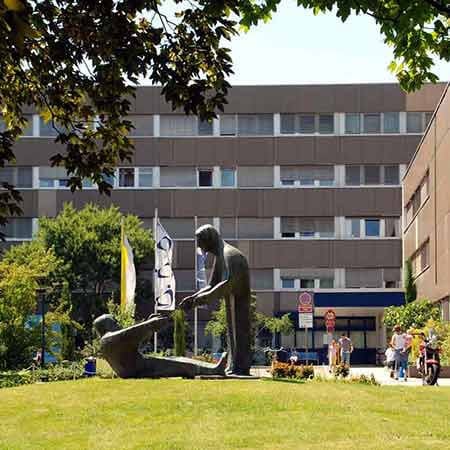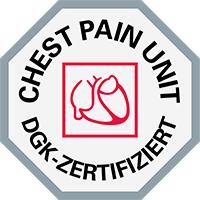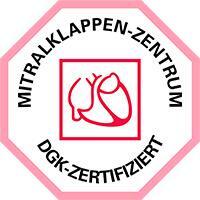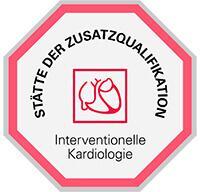Today, coronary insufficiency ranks first among the causes of death worldwide. The pathological basis of this condition is "oxygen starvation" of the heart muscle due to insufficient blood flow through the coronary (heart feeding) arteries. The disease mostly affects elderly people whose blood vessels are affected by atherosclerosis. It is important to know the mechanism of the disease, how it manifests itself, and what treatment methods are available.
Content
- Why does coronary insufficiency occur?
- Symptoms of coronary insufficiency
- Complications associated with coronary insufficiency
- Diagnostics of coronary insufficiency
- Treatment of coronary insufficiency
- The cost of treatment in European hospitals
Why does coronary insufficiency occur?
The most common cause of coronary artery disease, as the main manifestation of coronary insufficiency, is atherosclerosis of the blood vessels and, in particular, the coronary arteries. The causes of atherosclerosis can be, in turn, numerous.
Atherosclerosis is a disease in which fat-like substances (cholesterol) are deposited on the inner surface of artery walls in the form of spots. These spots may resolve and disappear, but they may enlarge and build up. In this case, there is a growth of connective (scar tissue) around the accumulation of fat-like substances, so a scar is formed, in which lime is deposited. Thus, the so-called atherosclerotic plaques develop. A part of the substances deposited in plaques can also dissolve and disappear.
Scientists have proved that atherosclerosis in its early stage of development is a reversible process, i.e. atherosclerotic plaques can dissolve and disappear as a result of improving working conditions, everyday life, diet, and some healthy habitual behaviors. It should be noted that atherosclerosis is not only heart disease. It can affect all vessels of the body, including the brain, kidney, vessels of the eyes, limbs, abdominal cavity, etc.
It leads to disruption of the function of the corresponding organs and systems of the nervous, cardiovascular, endocrine, kidney, liver, gastrointestinal tract, etc. It used to be believed that atherosclerosis was an inevitable companion only of the elderly and senile age. Indeed, it is most common in the elderly. However, atherosclerosis can also develop at a relatively young age of 30-40 years. On the other hand, even at the age of 70-80 years, it may be absent (or not manifested at all) or may be manifesting so weakly that it does not affect the vital functions of the body.
The emergence and development of atherosclerosis play a major role in functional disorders of the nervous system, and metabolic disorders. Improper work and rest mode, leading to sleep disorders, nervous and mental overstrain, as well as heavy, prolonged experience, increased blood pressure, irrational nutrition, various untreated chronic diseases are the main reasons contributing to the occurrence of atherosclerosis.
Speaking about the role of nutrition, particularly fatty foods, in the development of atherosclerosis, it should be noted that not always and not everyone who is consuming fatty foods are at increased risk of atherosclerosis. If the food contains a lot of vitamin C (ascorbic acid), then atherosclerosis may not develop and has appeared in the early stage of the disease, it can easily be reversed. Thus, atherosclerosis can not be considered an obligatory consequence of only a poor diet and consuming large amounts of fat-like substances. Atherosclerosis can develop only under certain conditions such as functional disorders of the nervous system, metabolic disorders, an irregular lifestyle, lack of physical activity, poor nutrition. For people who have already been diagnosed with atherosclerosis, these conditions may contribute to its further development.
Occurrence and development of the condition are also promoted by smoking (nicotine) and alcohol consumption. By perverting the reactivity of blood vessels, substance impact causes their spasm, malnutrition, and thus creates a favorable foundation for atherosclerosis. Infectious (contagious) diseases like syphilis, and chronic intoxication can also contribute to the development of atherosclerosis. Active work and an active lifestyle are of great importance for the prevention of this disease.
Symptoms of coronary insufficiency
The clinical forms of coronary heart disease and coronary insufficiency itself are varied: from asymptomatic variants to sudden coronary death. Intermediate and most frequent forms include angina pectoris, myocardial infarction, postinfarction cardiosclerosis, and cardiac rhythm disturbances.
The symptomatology of coronary heart disease is associated primarily with an insufficient supply of oxygen to the heart muscle when it needs it more than usual, for example, during physical or emotional stress. When this happens, a characteristic pain in the chest develops – angina.
Frequently recurring pain or prolonged attacks are called unstable angina, which creates a high risk of myocardial infarction if emergency medical care is not provided. Myocardial infarction is a serious condition with a high mortality rate that requires immediate treatment, including surgery. Myocardial infarction involves acute blockage of a coronary artery and the necrosis of the part of the muscle wall of the heart that is supplied by the artery. The heart wall stops contracting, the cardiac output of blood into the general bloodstream is disturbed, and thus acute heart failure develops, which is fatal in half of all cases.
What causes the pain in coronary artery insufficiency? With angina manifestation of coronary artery insufficiency, the pain is caused by spasm (compression) of the coronary vessels due to various reasons. As a consequence, blood flow to the heart suddenly decreases or stops (depending on the duration of the spasm), and the heart sort of "signals" about the disease. The disturbance of blood supply to the heart muscle leads to the decreased oxygen content in it (hypoxia), to metabolic disorders, which in turn cause a significant increase in the sensitivity of nerve plexuses embedded in the walls of coronary vessels. As a consequence, the patient feels tightness in the chest or pain. If the pain attack lasts long, as a result of necrosis of some part of the heart muscle, substances (histamine, vasopressin, adrenaline) enter the blood, which poison the body, maintain the state of spasm (narrowing) of heart vessels and thus contribute to the development of foci of necrosis in the heart muscle.
Therefore, it is very important that when you feel tightness, heaviness in the chest, and if the attack occurs, it should be eliminated as soon as possible. It is necessary to contact the doctor immediately to find out the true cause of pain in the heart. Sometimes patients themselves are trying to diagnose their illness based only on the pain. But the pain may be of a different origin, sometimes not even having anything to do with heart disease.
With a long-term and complex course of coronary artery disease, the process may take a persistent nature. There appear new deposits on old plaques, which, increasing in size, gradually narrow the lumen of the arteries and lead to a decrease in blood flow to the heart. In addition, vessels affected by sclerosis become less elastic, they can not expand according to the needs of the body to maintain normal blood flow.
Sometimes during strenuous physical work, when walking, the altered arteries, instead of expanding, narrow, that is, vasospasm occurs, which, as mentioned above, is the basis of angina pectoris. However, the sclerotic lesion of the heart is not limited to this. An outgrowth of connective tissue in the vessels gradually leads to so-called cardiosclerosis – a sclerotic lesion of the myocardium (heart muscle).
Such a combination of a painful (sclerotic) process in vessels and the heart muscle leads not only to the impairment of venous circulation, but also to the development of other types of heart impairment, including rhythm disorders, weakening of heart activity, reduced ability to work, and other serious complications. That is why medicine attaches crucial importance to the fight against sclerosis as the main cause of heart failure, early detection of sclerotic vascular changes, and their timely elimination.
Complications associated with coronary insufficiency
Disruption of natural function in the heart muscle causes many life-threatening changes in the body. First of all, they concern the general functioning of the cardiovascular system. The result of the destructive effect of coronary artery disease include:
- Insufficient metabolic processes in myocardial cells.
- Permanent tonicity of the heart ventricles.
- Muscle tissue scarring.
- Disruption of the main cardiac function (blood pumping).
All these complications lead to a single denominator – heart failure. Which, in turn, has irreversible negative effects on all internal organs. A patient has constant shortness of breath, chills, edema. Due to constant pain and the inability to breathe properly, motor activity decreases. A person becomes disabled.
In the early stage, coronary artery disease is treatable. In the acute form, the pathological processes can only be stabilized. Untimely or incorrect treatment of coronary artery disease sharply reduces the chances of recovery.
Diagnostics of coronary insufficiency
The main manifestation of coronary insufficiency and coronary artery disease is a pain in the heart region and behind the sternum of varying duration (from several seconds to 10-15 minutes) and intensity. Pain may be stabbing, squeezing, or pressing. It often occurs during or after physical or mental tension, cooling, under adverse weather conditions (strong wind, high humidity, fog, thunderstorm, sharp decrease in atmospheric pressure).
If the pain occurs as an attack and is not relieved, then a more severe form of coronary artery insufficiency, myocardial infarction, should be suspected.
An informative method for diagnosing coronary insufficiency is electrocardiography – the monitoring of the bioelectric heart currents. It is especially important to use this method when coronary artery insufficiency is not manifested by pain but is suspected based on unpleasant feelings of uncertain nature in the heart, shortness of breath, rapid fatigability, arrhythmia, etc. Although electrocardiographic changes do not always confirm the diagnosis (sometimes even during an angina attack, the electrocardiogram may be normal), it is still possible to identify characteristic signs of coronary insufficiency in most patients using this method with other possibilities (exercise testing, registration in many leads).
Currently, there are also other methods for detecting coronary artery insufficiency, including vectorcardiography, ballistocardiography, various biochemical and immunological tests, which are valuable additional diagnostic methods.
Treatment of coronary insufficiency
If you see a specialist in a timely manner and follow the doctor's recommendations, you can improve your life and get rid of the disturbing symptoms. Therapy may include medication, invasive or noninvasive surgery, and prophylaxis. Measures should be aimed at correcting the diet, reducing weight and treating arterial hypertension. Physical activity is contraindicated for the patient because, with coronary heart disease, the myocardium suffers from a lack of oxygen and nutrients. The load is gradually increased during the rehabilitation period. Nutrition is adjusted in a way unable to provoke atherosclerosis. The intake of fats, salt, smoked and canned foods is limited. With symptoms of coronary artery disease, prevention plays an important role.
Medication to treat coronary artery insufficiency may include:
- The use of beta-adrenoblockers, which slow the heart rate, thereby reducing the need for oxygen.
- Statins to prevent the development of plaques, and anticoagulants to reduce the risk of thrombosis.
- Diuretics to eliminate edema.
- If pain is severe and there are no contraindications, the doctor may prescribe nitrates.
If there is a high risk of heart attack, a surgical intervention may be indicated. The decision is made individually in each case. The techniques of stenting and bypass surgery are usually the primary choices.
Both psychological and physiological factors play a role in the development of the disease. Coronary insufficiency and coronary artery disease treatment do not always imply an operation and a long recovery period. If treated early, you can only take medications, but you need to adhere to a healthy lifestyle. An experienced cardiologist will determine tactics and help prolong life. With that said, if a patient has an acute circulatory disorder, angina attacks become more frequent, medications are prescribed to eliminate the pain attack and restore the disturbed functions of the heart. Drugs are also used to treat a number of concomitant diseases that worsen the condition of the patient suffering from cardiovascular disease. There are also cases where a thorough examination of the patient reveals signs of a recent myocardial infarction, which requires the use of drugs.
Under all of the above conditions, drug treatment is necessary and appropriate, as it helps to restore the function of the cardiovascular system, and prepares a favorable background for the use of spa therapeutic factors. On individual indications, drugs can be successfully combined with physiotherapy. This increases the effectiveness of treatment, especially in cases where some tactics do not give the expected good results.
In some cases, active treatment methods are required, which include procedures aimed at restoring and improving blood flow:
- Angioplasty and stenting imply enlarging the vessel wall and placing a stent to preserve the normal lumen of the vessel.
- Coronary artery bypass surgery implies the restoration of blood flow by creating a bypass for a narrowed artery (using a graft – a section of the vessel from another part of the patient's body).
The main advantage of percutaneous coronary interventions is that it is an endovascular or closed method of vascular surgery and is performed without opening the chest or large incisions. The operation is minimally traumatic, safe, almost painless, patients tolerate the operation easier and have a faster recovery period. However, it is important to know that the choice of treatment method in favor of balloon angioplasty and stenting depends mainly on the anatomy of the vessel lesion. In patients with a single double-vessel lesion and not in the initial part of the artery, but, for example, in its central part, stenting is preferable.
In the case of multiple coronary artery lesions, percutaneous coronary interventions have so far very modest possibilities. Stenting in these situations is often useless or impossible. Stenting procedure loses to bypass procedure in terms of long-term results. As numerous international studies show, a patient who has undergone stenting often requires repeated endovascular or surgical intervention. Also, it should be remembered that after stenting, the patient needs to take special antithrombotic medications for life.
The cost of treatment in European hospitals
The treatment in Europe is represented by services provided by public and private hospitals. With the high demand for treatment in European hospitals, it is advisable to consider the resources of both types of medical institutions for treatment in Europe. The cost of treatment and diagnosis in a private hospital in Europe may be higher, but will save time and ultimately reduce the overall price for the trip, since you do not have to wait for that much as you may be forced to do at a public hospital.
The price policy of state European hospitals is regulated by the Ministry of Health of each country in Europe, which approves the basic prices for services for foreign citizens. Nevertheless, the law does not prohibit health care providers from setting the cost of treatment based on the situation that may or may not require urgent and radical measures.
Booking Health can calculate the cost of treatment in European hospitals for your case. For that, all you need to do is fill in the request form on the Booking Health website.
Booking Health adheres to the principle of financial transparency. At the same time, Booking Health provides treatment arrangements and complete follow-up services. Only the additional services that you decide to include before you travel will be charged.
Thus, the treatment will cost you the same as when you go directly to the hospital, only with a high-quality service, which international departments of hospitals cannot provide, having a standard work schedule and narrow staffing.
Authors: Dr. Nadezhda Ivanisova, Dr. Sergey Pashchenko


















